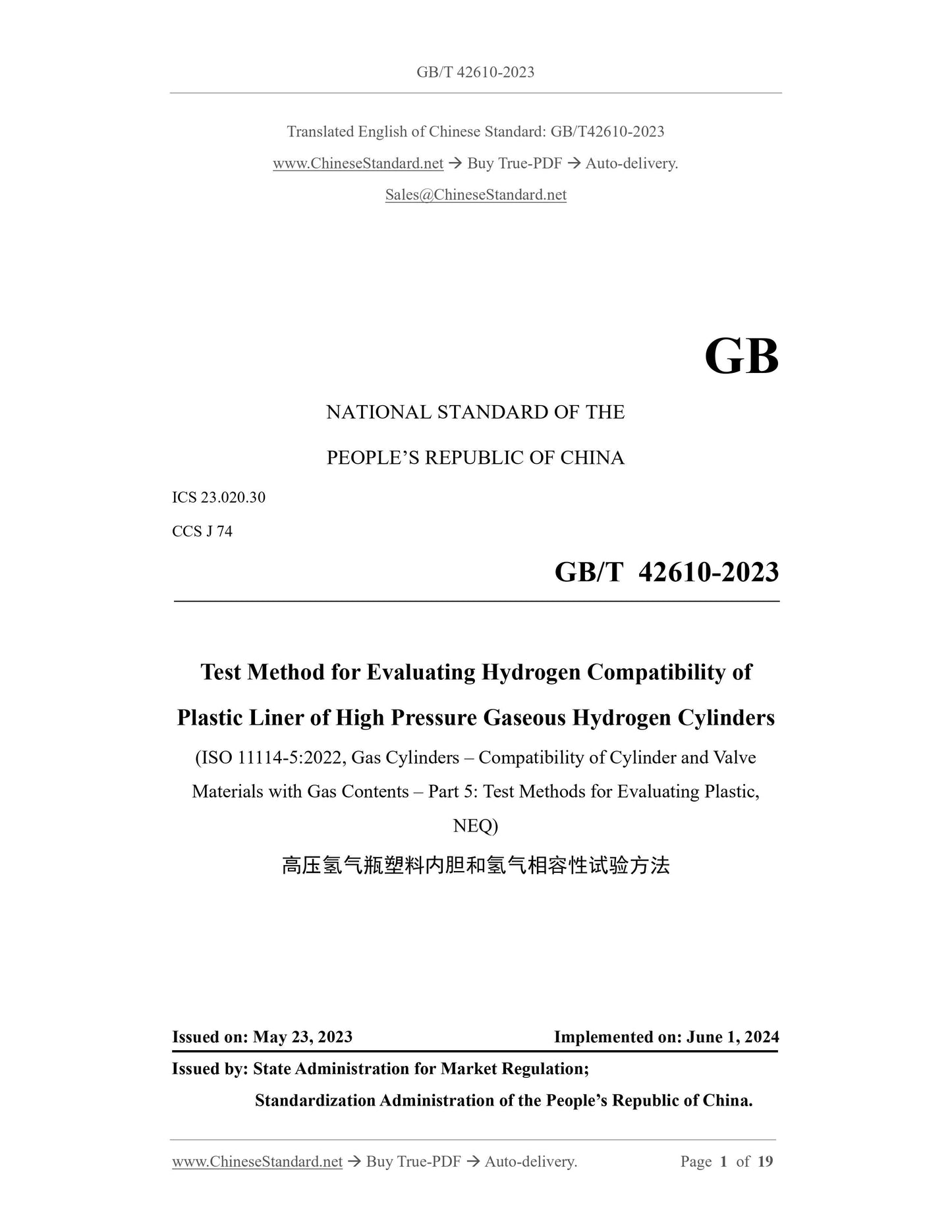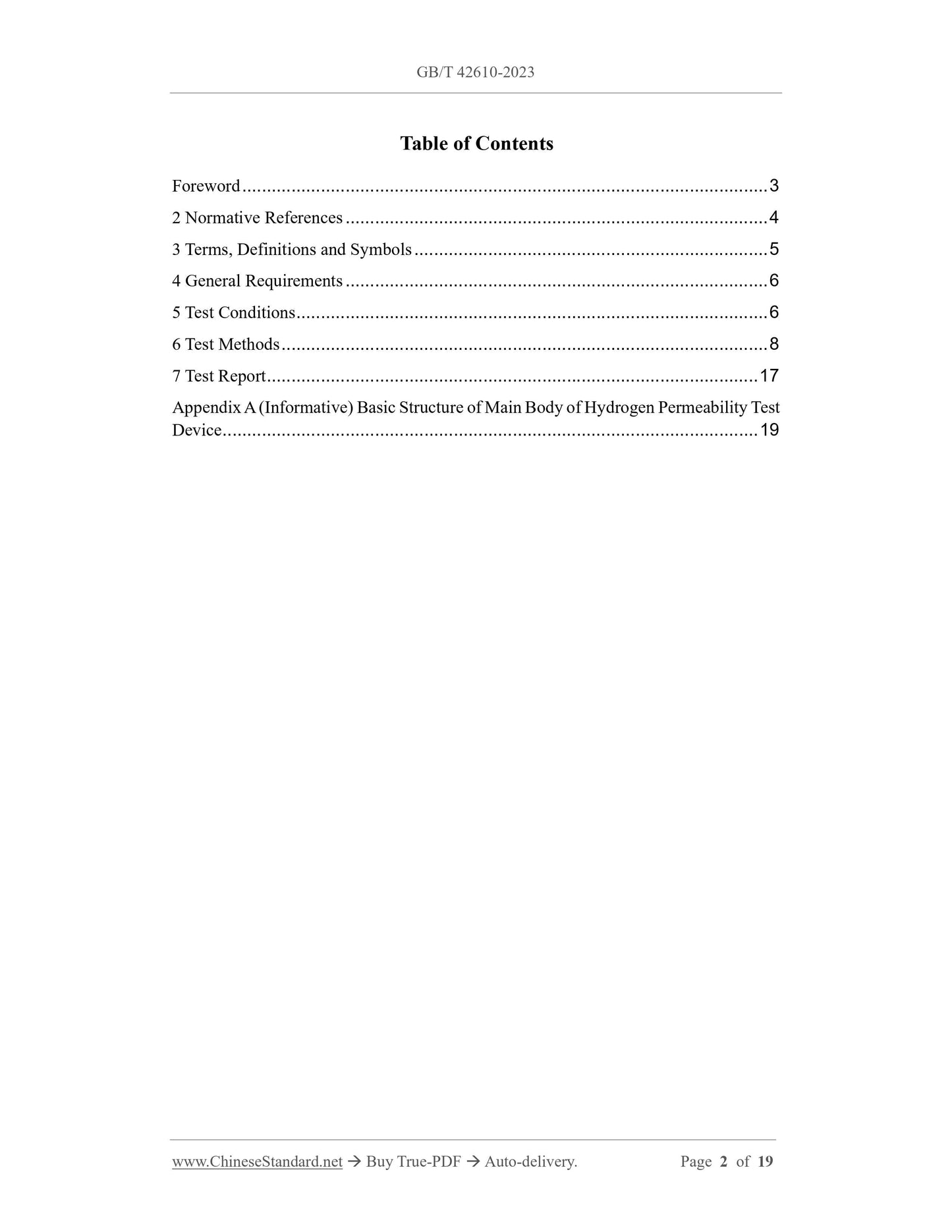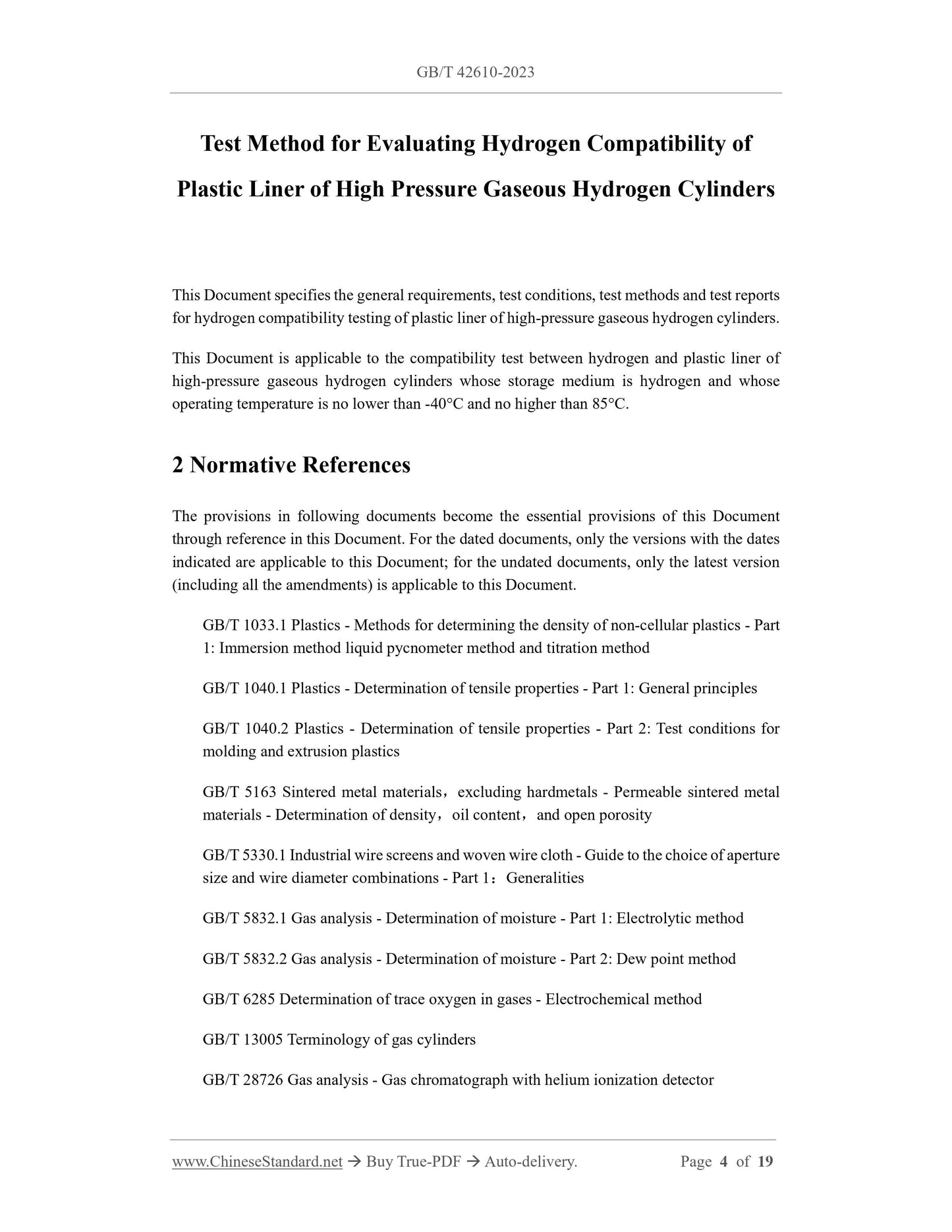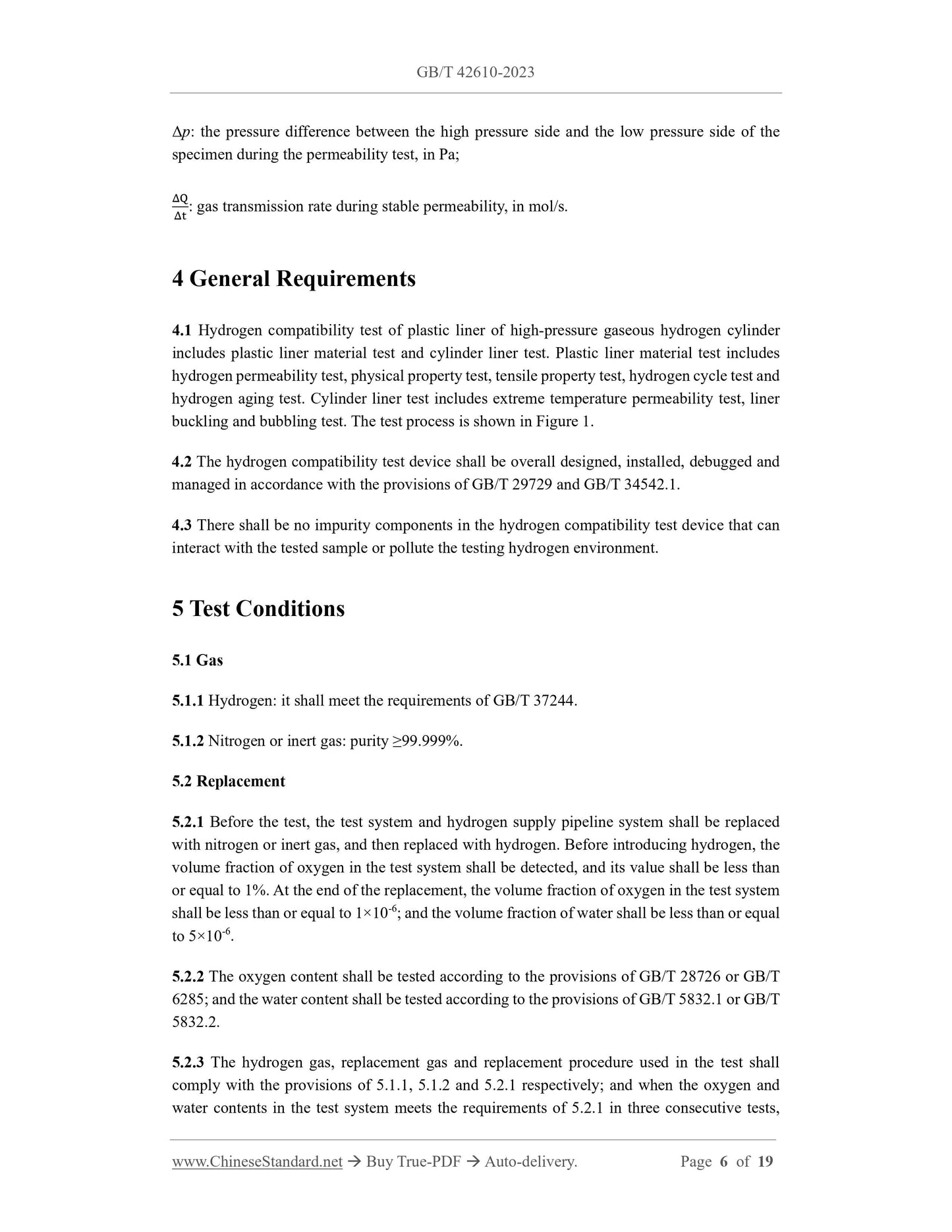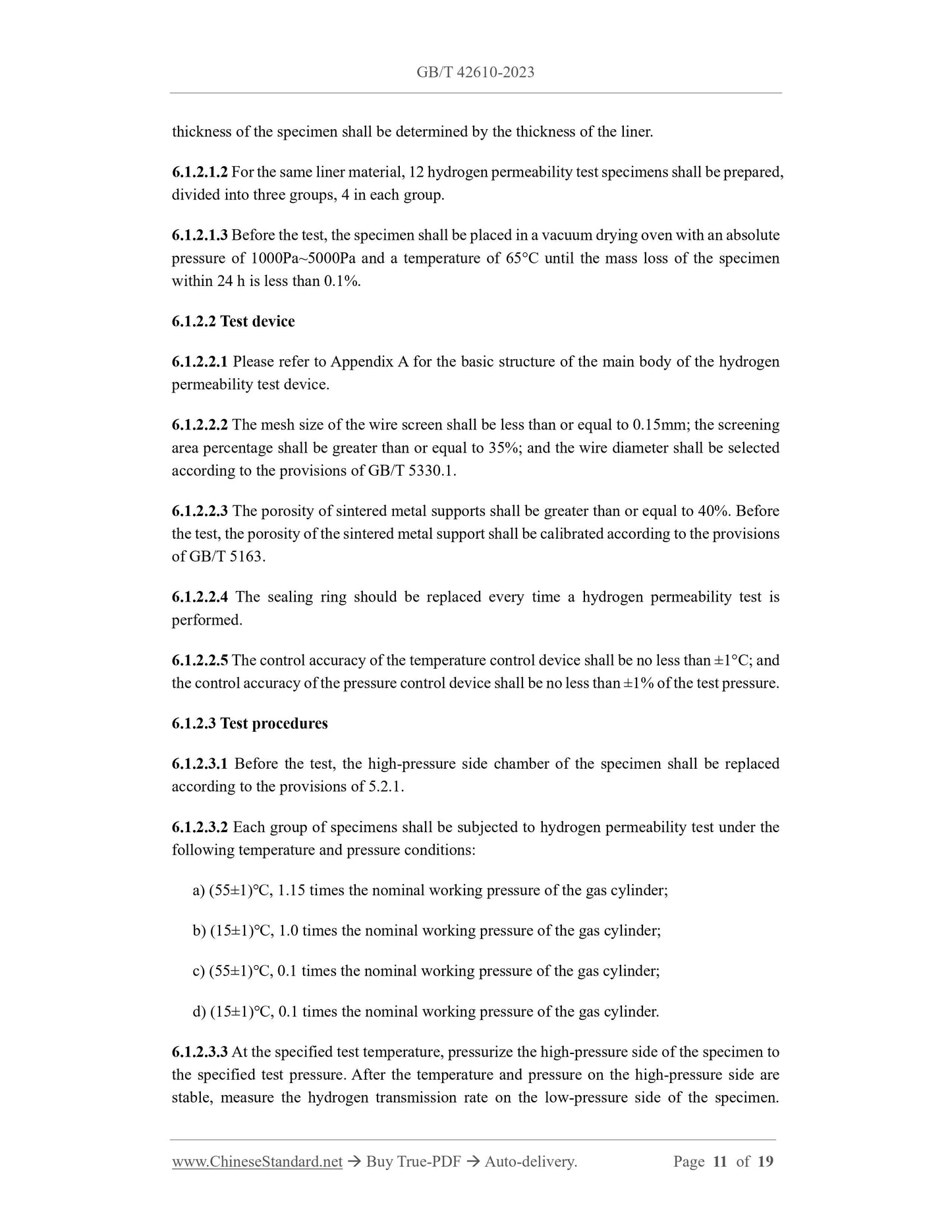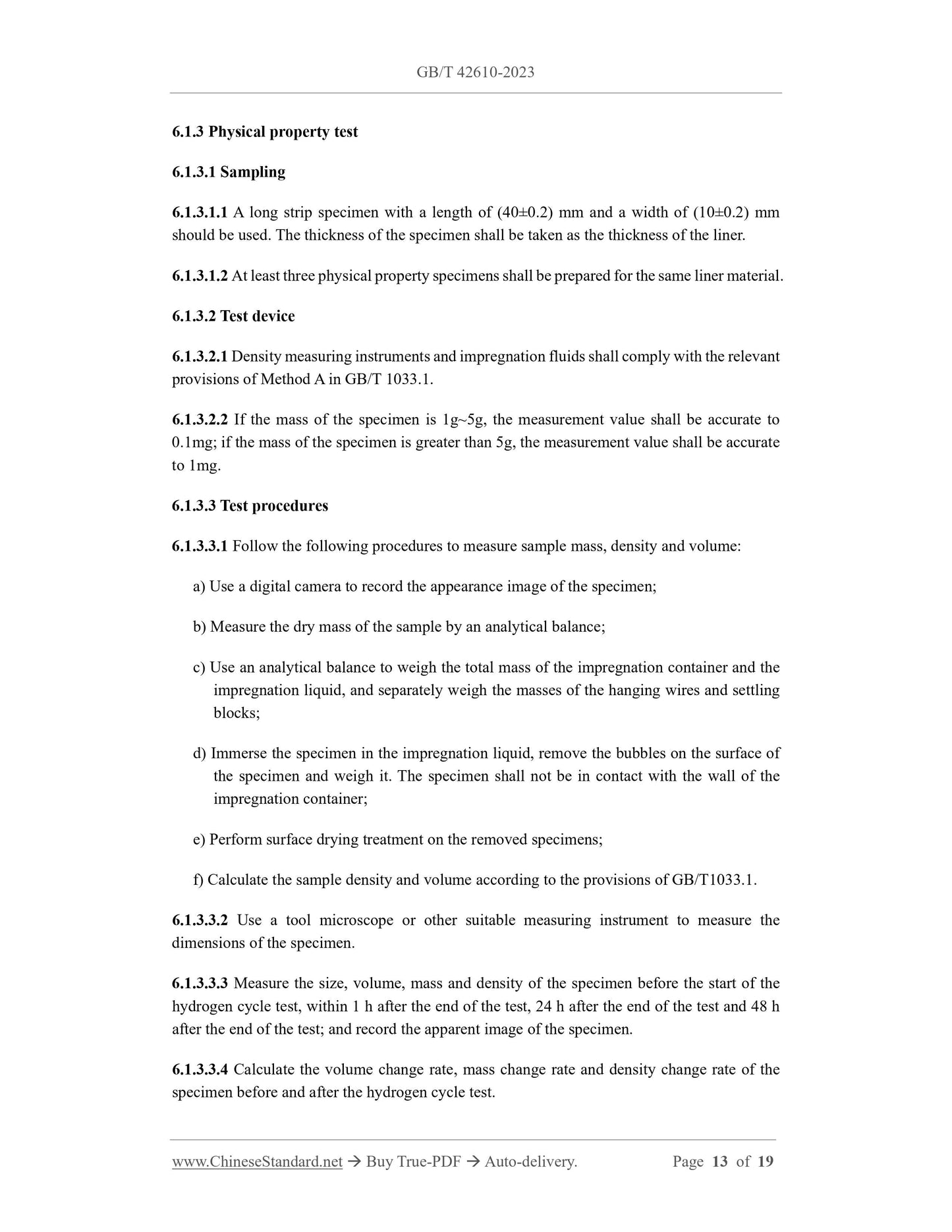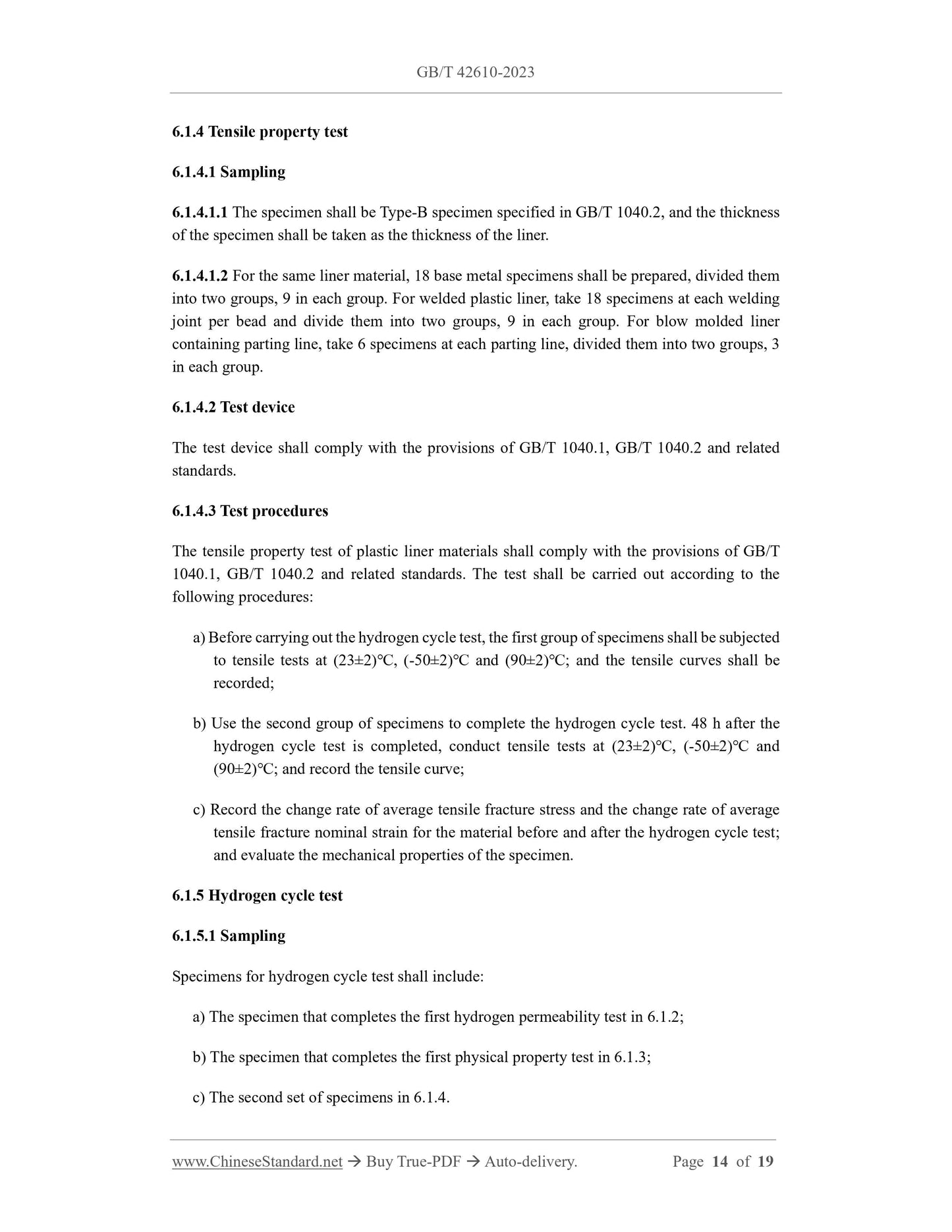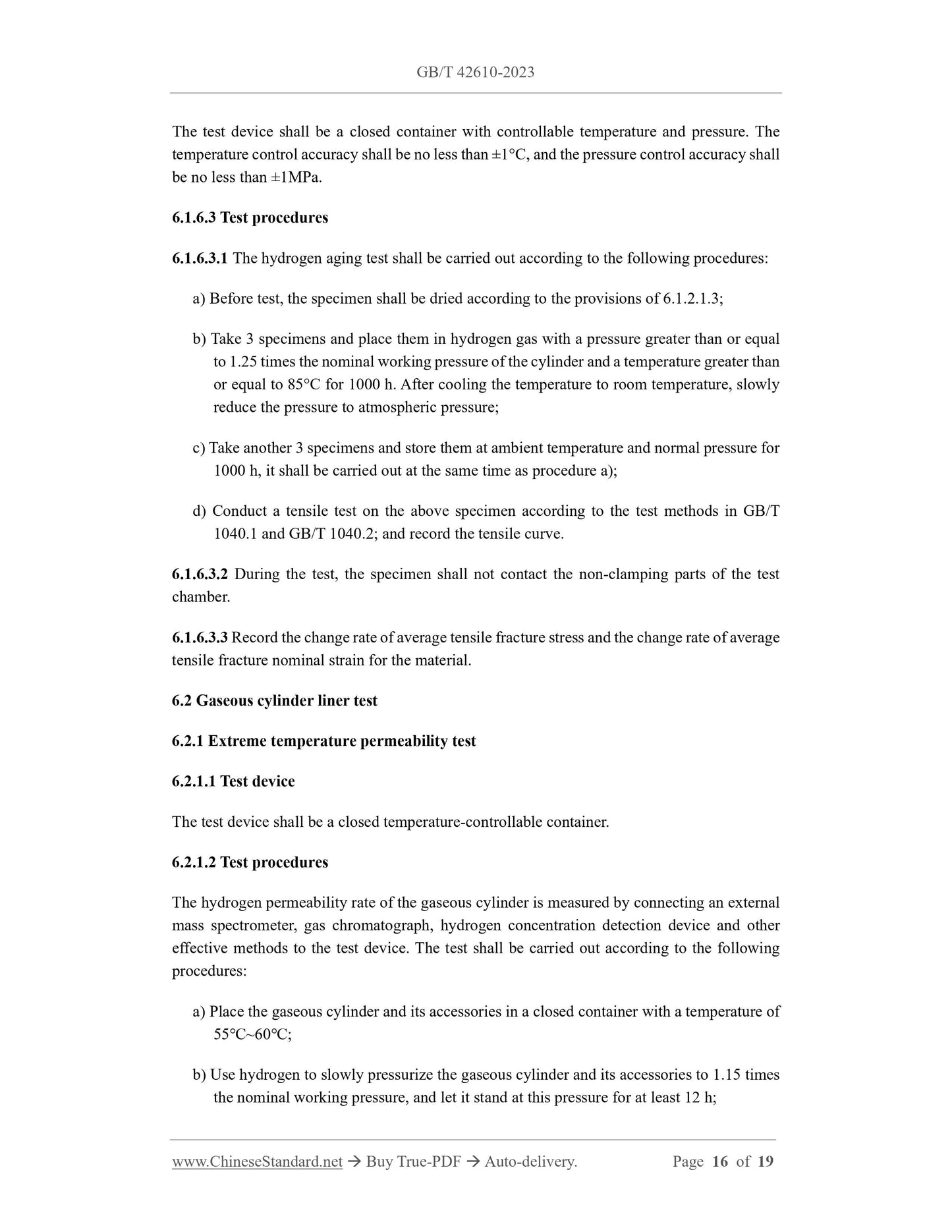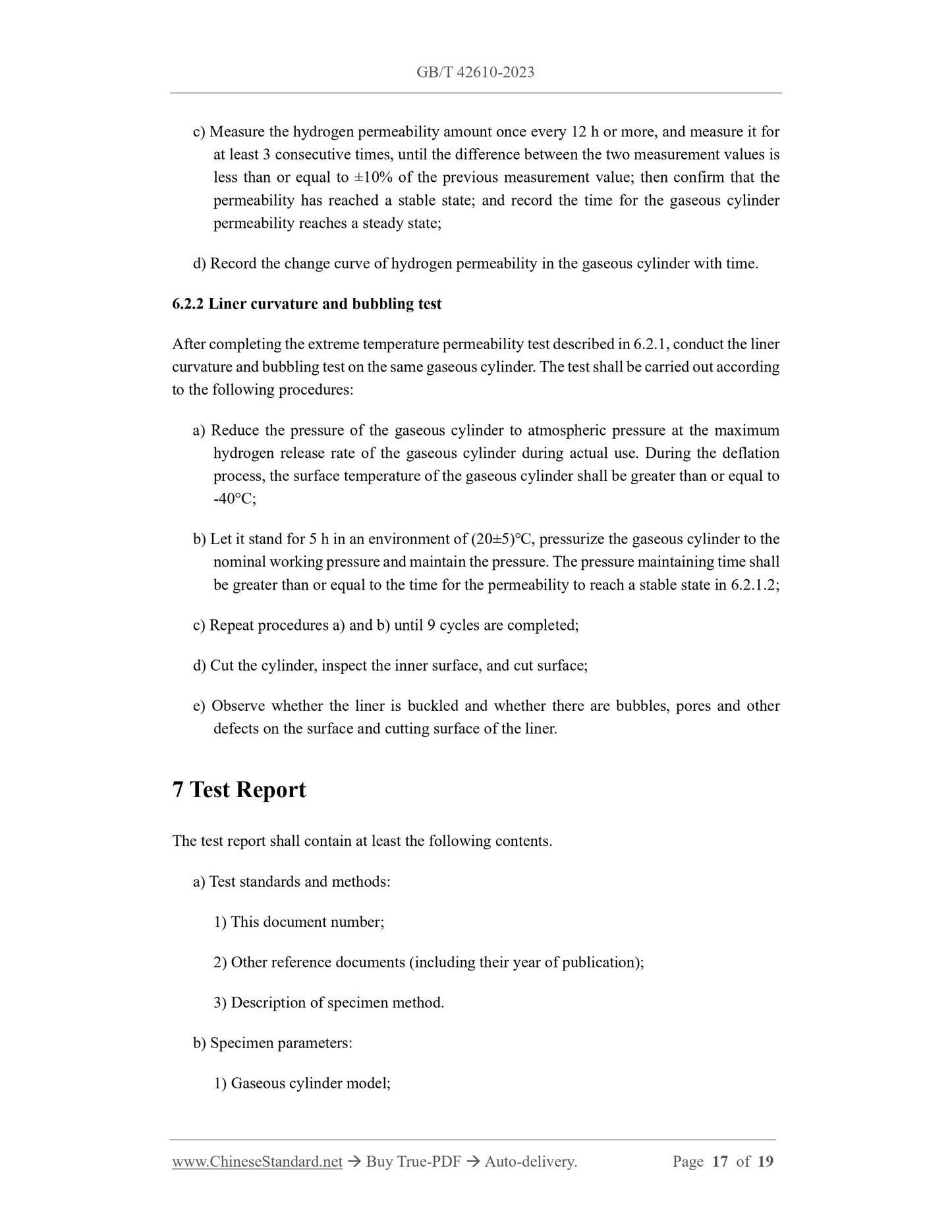1
/
of
9
PayPal, credit cards. Download editable-PDF and invoice in 1 second!
GB/T 42610-2023 English PDF (GBT42610-2023)
GB/T 42610-2023 English PDF (GBT42610-2023)
Regular price
$245.00 USD
Regular price
Sale price
$245.00 USD
Unit price
/
per
Shipping calculated at checkout.
Couldn't load pickup availability
Delivery: 3 seconds. Download true-PDF + Invoice.
Get QUOTATION in 1-minute: Click GB/T 42610-2023
Historical versions: GB/T 42610-2023
Preview True-PDF (Reload/Scroll if blank)
GB/T 42610-2023: Test method for evaluating hydrogen compatibility of plastic liner of high pressure gaseous hydrogen cylinders
GB/T 42610-2023
GB
NATIONAL STANDARD OF THE
PEOPLE’S REPUBLIC OF CHINA
ICS 23.020.30
CCS J 74
Test Method for Evaluating Hydrogen Compatibility of
Plastic Liner of High Pressure Gaseous Hydrogen Cylinders
(ISO 11114-5:2022, Gas Cylinders – Compatibility of Cylinder and Valve
Materials with Gas Contents – Part 5: Test Methods for Evaluating Plastic,
NEQ)
ISSUED ON: MAY 23, 2023
IMPLEMENTED ON: JUNE 1, 2024
Issued by: State Administration for Market Regulation;
Standardization Administration of the People’s Republic of China.
Table of Contents
Foreword ... 3
2 Normative References ... 4
3 Terms, Definitions and Symbols ... 5
4 General Requirements ... 6
5 Test Conditions ... 6
6 Test Methods ... 8
7 Test Report ... 17
Appendix A (Informative) Basic Structure of Main Body of Hydrogen Permeability Test
Device ... 19
Test Method for Evaluating Hydrogen Compatibility of
Plastic Liner of High Pressure Gaseous Hydrogen Cylinders
This Document specifies the general requirements, test conditions, test methods and test reports
for hydrogen compatibility testing of plastic liner of high-pressure gaseous hydrogen cylinders.
This Document is applicable to the compatibility test between hydrogen and plastic liner of
high-pressure gaseous hydrogen cylinders whose storage medium is hydrogen and whose
operating temperature is no lower than -40°C and no higher than 85°C.
2 Normative References
The provisions in following documents become the essential provisions of this Document
through reference in this Document. For the dated documents, only the versions with the dates
indicated are applicable to this Document; for the undated documents, only the latest version
(including all the amendments) is applicable to this Document.
GB/T 1033.1 Plastics - Methods for determining the density of non-cellular plastics - Part
1: Immersion method liquid pycnometer method and titration method
GB/T 1040.1 Plastics - Determination of tensile properties - Part 1: General principles
GB/T 1040.2 Plastics - Determination of tensile properties - Part 2: Test conditions for
molding and extrusion plastics
GB/T 5163 Sintered metal materials, excluding hardmetals - Permeable sintered metal
materials - Determination of density, oil content, and open porosity
GB/T 5330.1 Industrial wire screens and woven wire cloth - Guide to the choice of aperture
size and wire diameter combinations - Part 1: Generalities
GB/T 5832.1 Gas analysis - Determination of moisture - Part 1: Electrolytic method
GB/T 5832.2 Gas analysis - Determination of moisture - Part 2: Dew point method
GB/T 6285 Determination of trace oxygen in gases - Electrochemical method
GB/T 13005 Terminology of gas cylinders
GB/T 28726 Gas analysis - Gas chromatograph with helium ionization detector
Δp: the pressure difference between the high pressure side and the low pressure side of the
specimen during the permeability test, in Pa;
୕
୲ : gas transmission rate during stable permeability, in mol/s.
4 General Requirements
4.1 Hydrogen compatibility test of plastic liner of high-pressure gaseous hydrogen cylinder
includes plastic liner material test and cylinder liner test. Plastic liner material test includes
hydrogen permeability test, physical property test, tensile property test, hydrogen cycle test and
hydrogen aging test. Cylinder liner test includes extreme temperature permeability test, liner
buckling and bubbling test. The test process is shown in Figure 1.
4.2 The hydrogen compatibility test device shall be overall designed, installed, debugged and
managed in accordance with the provisions of GB/T 29729 and GB/T 34542.1.
4.3 There shall be no impurity components in the hydrogen compatibility test device that can
interact with the tested sample or pollute the testing hydrogen environment.
5 Test Conditions
5.1 Gas
5.1.1 Hydrogen: it shall meet the requirements of GB/T 37244.
5.1.2 Nitrogen or inert gas: purity ≥99.999%.
5.2 Replacement
5.2.1 Before the test, the test system and hydrogen supply pipeline system shall be replaced
with nitrogen or inert gas, and then replaced with hydrogen. Before introducing hydrogen, the
volume fraction of oxygen in the test system shall be detected, and its value shall be less than
or equal to 1%. At the end of the replacement, the volume fraction of oxygen in the test system
shall be less than or equal to 1×10-6; and the volume fraction of water shall be less than or equal
to 5×10-6.
5.2.2 The oxygen content shall be tested according to the provisions of GB/T 28726 or GB/T
6285; and the water content shall be tested according to the provisions of GB/T 5832.1 or GB/T
5832.2.
5.2.3 The hydrogen gas, replacement gas and replacement procedure used in the test shall
comply with the provisions of 5.1.1, 5.1.2 and 5.2.1 respectively; and when the oxygen and
water contents in the test system meets the requirements of 5.2.1 in three consecutive tests,
thickness of the specimen shall be determined by the thickness of the liner.
6.1.2.1.2 For the same liner material, 12 hydrogen permeability test specimens shall be prepared,
divided into three groups, 4 in each group.
6.1.2.1.3 Before the test, the specimen shall be placed in a vacuum drying oven with an absolute
pressure of 1000Pa~5000Pa and a temperature of 65°C until the mass loss of the specimen
within 24 h is less than 0.1%.
6.1.2.2 Test device
6.1.2.2.1 Please refer to Appendix A for the basic structure of the main body of the hydrogen
permeability test device.
6.1.2.2.2 The mesh size of the wire screen shall be less than or equal to 0.15mm; the screening
area percentage shall be greater than or equal to 35%; and the wire diameter shall be selected
according to the provisions of GB/T 5330.1.
6.1.2.2.3 The porosity of sintered metal supports shall be greater than or equal to 40%. Before
the test, the porosity of the sintered metal support shall be calibrated according to the provisions
of GB/T 5163.
6.1.2.2.4 The sealing ring should be replaced every time a hydrogen permeability test is
performed.
6.1.2.2.5 The control accuracy of the temperature control device shall be no less than ±1°C; and
the control accuracy of the pressure control device shall be no less than ±1% of the test pressure.
6.1.2.3 Test procedures
6.1.2.3.1 Before the test, the high-pressure side chamber of the specimen shall be replaced
according to the provisions of 5.2.1.
6.1.2.3.2 Each group of specimens shall be subjected to hydrogen permeability test under the
following temperature and pressure conditions:
a) (55±1)℃, 1.15 times the nominal working pressure of the gas cylinder;
b) (15±1)℃, 1.0 times the nominal working pressure of the gas cylinder;
c) (55±1)℃, 0.1 times the nominal working pressure of the gas cylinder;
d) (15±1)℃, 0.1 times the nominal working pressure of the gas cylinder.
6.1.2.3.3 At the specified test temperature, pressurize the high-pressure side of the specimen to
the specified test pressure. After the temperature and pressure on the high-pressure side are
stable, measure the hydrogen transmission rate on the low-pressure side of the specimen.
6.1.3 Physical property test
6.1.3.1 Sampling
6.1.3.1.1 A long strip specimen with a length of (40±0.2) mm and a width of (10±0.2) mm
should be used. The thickness of the specimen shall be taken as the thickness of the liner.
6.1.3.1.2 At least three physical property specimens shall be prepared for the same liner material.
6.1.3.2 Test devi...
Get QUOTATION in 1-minute: Click GB/T 42610-2023
Historical versions: GB/T 42610-2023
Preview True-PDF (Reload/Scroll if blank)
GB/T 42610-2023: Test method for evaluating hydrogen compatibility of plastic liner of high pressure gaseous hydrogen cylinders
GB/T 42610-2023
GB
NATIONAL STANDARD OF THE
PEOPLE’S REPUBLIC OF CHINA
ICS 23.020.30
CCS J 74
Test Method for Evaluating Hydrogen Compatibility of
Plastic Liner of High Pressure Gaseous Hydrogen Cylinders
(ISO 11114-5:2022, Gas Cylinders – Compatibility of Cylinder and Valve
Materials with Gas Contents – Part 5: Test Methods for Evaluating Plastic,
NEQ)
ISSUED ON: MAY 23, 2023
IMPLEMENTED ON: JUNE 1, 2024
Issued by: State Administration for Market Regulation;
Standardization Administration of the People’s Republic of China.
Table of Contents
Foreword ... 3
2 Normative References ... 4
3 Terms, Definitions and Symbols ... 5
4 General Requirements ... 6
5 Test Conditions ... 6
6 Test Methods ... 8
7 Test Report ... 17
Appendix A (Informative) Basic Structure of Main Body of Hydrogen Permeability Test
Device ... 19
Test Method for Evaluating Hydrogen Compatibility of
Plastic Liner of High Pressure Gaseous Hydrogen Cylinders
This Document specifies the general requirements, test conditions, test methods and test reports
for hydrogen compatibility testing of plastic liner of high-pressure gaseous hydrogen cylinders.
This Document is applicable to the compatibility test between hydrogen and plastic liner of
high-pressure gaseous hydrogen cylinders whose storage medium is hydrogen and whose
operating temperature is no lower than -40°C and no higher than 85°C.
2 Normative References
The provisions in following documents become the essential provisions of this Document
through reference in this Document. For the dated documents, only the versions with the dates
indicated are applicable to this Document; for the undated documents, only the latest version
(including all the amendments) is applicable to this Document.
GB/T 1033.1 Plastics - Methods for determining the density of non-cellular plastics - Part
1: Immersion method liquid pycnometer method and titration method
GB/T 1040.1 Plastics - Determination of tensile properties - Part 1: General principles
GB/T 1040.2 Plastics - Determination of tensile properties - Part 2: Test conditions for
molding and extrusion plastics
GB/T 5163 Sintered metal materials, excluding hardmetals - Permeable sintered metal
materials - Determination of density, oil content, and open porosity
GB/T 5330.1 Industrial wire screens and woven wire cloth - Guide to the choice of aperture
size and wire diameter combinations - Part 1: Generalities
GB/T 5832.1 Gas analysis - Determination of moisture - Part 1: Electrolytic method
GB/T 5832.2 Gas analysis - Determination of moisture - Part 2: Dew point method
GB/T 6285 Determination of trace oxygen in gases - Electrochemical method
GB/T 13005 Terminology of gas cylinders
GB/T 28726 Gas analysis - Gas chromatograph with helium ionization detector
Δp: the pressure difference between the high pressure side and the low pressure side of the
specimen during the permeability test, in Pa;
୕
୲ : gas transmission rate during stable permeability, in mol/s.
4 General Requirements
4.1 Hydrogen compatibility test of plastic liner of high-pressure gaseous hydrogen cylinder
includes plastic liner material test and cylinder liner test. Plastic liner material test includes
hydrogen permeability test, physical property test, tensile property test, hydrogen cycle test and
hydrogen aging test. Cylinder liner test includes extreme temperature permeability test, liner
buckling and bubbling test. The test process is shown in Figure 1.
4.2 The hydrogen compatibility test device shall be overall designed, installed, debugged and
managed in accordance with the provisions of GB/T 29729 and GB/T 34542.1.
4.3 There shall be no impurity components in the hydrogen compatibility test device that can
interact with the tested sample or pollute the testing hydrogen environment.
5 Test Conditions
5.1 Gas
5.1.1 Hydrogen: it shall meet the requirements of GB/T 37244.
5.1.2 Nitrogen or inert gas: purity ≥99.999%.
5.2 Replacement
5.2.1 Before the test, the test system and hydrogen supply pipeline system shall be replaced
with nitrogen or inert gas, and then replaced with hydrogen. Before introducing hydrogen, the
volume fraction of oxygen in the test system shall be detected, and its value shall be less than
or equal to 1%. At the end of the replacement, the volume fraction of oxygen in the test system
shall be less than or equal to 1×10-6; and the volume fraction of water shall be less than or equal
to 5×10-6.
5.2.2 The oxygen content shall be tested according to the provisions of GB/T 28726 or GB/T
6285; and the water content shall be tested according to the provisions of GB/T 5832.1 or GB/T
5832.2.
5.2.3 The hydrogen gas, replacement gas and replacement procedure used in the test shall
comply with the provisions of 5.1.1, 5.1.2 and 5.2.1 respectively; and when the oxygen and
water contents in the test system meets the requirements of 5.2.1 in three consecutive tests,
thickness of the specimen shall be determined by the thickness of the liner.
6.1.2.1.2 For the same liner material, 12 hydrogen permeability test specimens shall be prepared,
divided into three groups, 4 in each group.
6.1.2.1.3 Before the test, the specimen shall be placed in a vacuum drying oven with an absolute
pressure of 1000Pa~5000Pa and a temperature of 65°C until the mass loss of the specimen
within 24 h is less than 0.1%.
6.1.2.2 Test device
6.1.2.2.1 Please refer to Appendix A for the basic structure of the main body of the hydrogen
permeability test device.
6.1.2.2.2 The mesh size of the wire screen shall be less than or equal to 0.15mm; the screening
area percentage shall be greater than or equal to 35%; and the wire diameter shall be selected
according to the provisions of GB/T 5330.1.
6.1.2.2.3 The porosity of sintered metal supports shall be greater than or equal to 40%. Before
the test, the porosity of the sintered metal support shall be calibrated according to the provisions
of GB/T 5163.
6.1.2.2.4 The sealing ring should be replaced every time a hydrogen permeability test is
performed.
6.1.2.2.5 The control accuracy of the temperature control device shall be no less than ±1°C; and
the control accuracy of the pressure control device shall be no less than ±1% of the test pressure.
6.1.2.3 Test procedures
6.1.2.3.1 Before the test, the high-pressure side chamber of the specimen shall be replaced
according to the provisions of 5.2.1.
6.1.2.3.2 Each group of specimens shall be subjected to hydrogen permeability test under the
following temperature and pressure conditions:
a) (55±1)℃, 1.15 times the nominal working pressure of the gas cylinder;
b) (15±1)℃, 1.0 times the nominal working pressure of the gas cylinder;
c) (55±1)℃, 0.1 times the nominal working pressure of the gas cylinder;
d) (15±1)℃, 0.1 times the nominal working pressure of the gas cylinder.
6.1.2.3.3 At the specified test temperature, pressurize the high-pressure side of the specimen to
the specified test pressure. After the temperature and pressure on the high-pressure side are
stable, measure the hydrogen transmission rate on the low-pressure side of the specimen.
6.1.3 Physical property test
6.1.3.1 Sampling
6.1.3.1.1 A long strip specimen with a length of (40±0.2) mm and a width of (10±0.2) mm
should be used. The thickness of the specimen shall be taken as the thickness of the liner.
6.1.3.1.2 At least three physical property specimens shall be prepared for the same liner material.
6.1.3.2 Test devi...
Share
